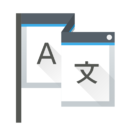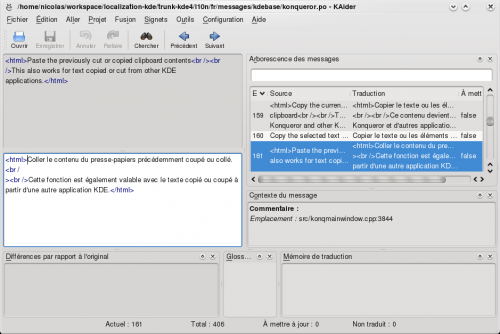Lokalize/de-formal: Difference between revisions
(Created page with "{{Input|1= git clone <nowiki>git://anongit.kde.org/lokalize</nowiki>}}oder") |
(Created page with "{{Input|1=git clone <nowiki>[email protected]:lokalize</nowiki>}} und anschließend {{Input|1=cd lokalize mkdir build cd build cmake -DCMAKE_BUILD_TYPE=RelWithDebInfo .. mak...") |
||
| Line 20: | Line 20: | ||
{{Input|1=git clone <nowiki>[email protected]:lokalize</nowiki>}} | {{Input|1=git clone <nowiki>[email protected]:lokalize</nowiki>}} | ||
und anschließend | |||
{{Input|1=cd lokalize | {{Input|1=cd lokalize | ||
mkdir build | mkdir build | ||
| Line 27: | Line 27: | ||
make -j2 | make -j2 | ||
./src/lokalize | ./src/lokalize | ||
}} | }}ein. | ||
==Downloading Lokalize binaries for Windows== | ==Downloading Lokalize binaries for Windows== | ||
Revision as of 13:07, 27 August 2020
 |
Lokalize ist ein Übersetzungwerkzeug für KDE und andere Open-Source-Software |
Lokalize' ist außerdem ein computerunterstütztes Übersetzungssystem (engl. computer-aided translation system / CAT) das die Übersetzung von OpenDocument-Textdokumenten (*.odt) ermöglicht. Intern kommt hierbei Translate-Toolkit zum Einsatz, welches den zu übersetzenden Text aus den .odt-Dateien in das .xliff-Format überführt und die übersetzten Zeichenketten in das .odt-Format einpflegt.
__Inhalt__

Lokalize vom KDE “trunk” kompilieren
Installieren Sie zuerst die Header-Pakete libkf5i18n-dev, libkf5completion-dev, libkf5itemviews-dev, libkf5sonnet-dev, kross-dev und libhunspell-dev. Und geben Sie dann:
git clone git://anongit.kde.org/lokalize
oder
git clone [email protected]:lokalize
und anschließend
cd lokalize mkdir build cd build cmake -DCMAKE_BUILD_TYPE=RelWithDebInfo .. make -j2 ./src/lokalize
ein.
Downloading Lokalize binaries for Windows
The latest release build of Lokalize for Windows is available on the KDE Binary Factory
The latest nightly build of Lokalize for Windows is also available on the KDE Binary Factory
Tips and tricks
Search in files
Translation Memory (TM) now keeps track of where each translation pair came from. So when you want to for string in the files on disk, you just drag the directory with those files onto tab (F7) to update TM, wait a minute or two, then type your string into right field of , then press Enter.
Then you click on one of results and this opens appropriate file, on the appropriate entry. When you want to do another search during the same day, you skip the updating step and just type what you're searching for. You can filter TM search results by filename using the field left side of the F7 panel ().
Author
Nick Shaforostoff Facebook page
